| This site is sponsored in part by the following non profit
organization:
Fine
Arts Foundation,Inc.
Houston, TX. . . http://fineartsfoundation.com/ |
 Support Texas Indians. Even $1.00 helps. It costs
to keep things going. So help. Paypal or a credit card in Paypal. It's
safe and YOU really help. You can afford a soda? Then send the cost of
a soda and send it to PayPal and help Texas Indians.com
Support Texas Indians. Even $1.00 helps. It costs
to keep things going. So help. Paypal or a credit card in Paypal. It's
safe and YOU really help. You can afford a soda? Then send the cost of
a soda and send it to PayPal and help Texas Indians.com
The
Texas Cherokee
By R Edward Moore
|Just the facts|Sources|
Back to the Texas Indians
home page at WWW.TexasIndians.com
A few Cherokee recipes
!!
NEW, Cherokee names
/ language!!!!
 |
"The Texas Cherokees", by Everett. A good book on the Texas Cherokees. In fact,
the only book on the Texas Cherokees. Thank God it is a good one. Sold out . |

Black Coat
by George Catlin painted in 1836. Notice the pipe he is holding and the
arrow in his hair.
I like the Cherokees because I am part
Cherokee. I am not a registered member of the tribe but, my Grandmother
was a Cherokee who lived in Oklahoma. There are a lot of Cherokees like
me who still live in Texas.
The Cherokees are one of the most important
tribes in Texas History. They are not originally from Texas. They moved
to Texas from the east around 1823. One reason the Cherokees are important
is because Sam Houston was an adopted Cherokee. Sam Houston was the first
President of the Republic of Texas and the General of the Texas Army that
defeated the Mexicans in the Texas Revolution in 1835. From Tennessee,
he followed his Cherokee family first to Arkansas in 1828, then to Texas
in 1832. Sam Houston's Cherokee name was "the Raven".
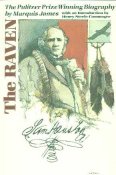 |
"The Raven" by Marquis James, A biography
of Sam Houston who was an adopted Cherokee. A good book by a Pulitzer
prize winning author. It is rapidly becoming "the classic" Sam
Houston biography. Sold out |
The Cherokees are also important in
Texas history because they took over the leadership role of the Indian
tribes of East Texas from the Caddo. They became the dominant Indian tribe
in East Texas.
The importance of the Cherokees in Texas
is more historical than cultural. By the time they arrived in Texas their
culture had become very much like the Americans and Europeans in many ways.
To find the original Cherokee Indian culture you have to go back 200 years
before they came to Texas.
The Cherokees are one of the five civilized
tribes. They were called this because by the time large numbers of European
settlers arrived around them, the Cherokees had already learned to make
and use metal tools, European style clothes and European style houses.
We will look at this in more detail later on.
The Cherokees are an Iroquoian speaking
people who originally lived in eastern Tennessee and the surrounding areas.
Their territory included almost all of Tennessee and Kentucky, the northern
part of Georgia, the northern part of Alabama, the eastern tips of North
and South Carolina and Virginia . This is a lot of territory and the Cherokees
were a big nation. They were a part of the larger mound-building cultures
of the Southeastern United States. The mound-building cultures included
many other Indian tribes or nations.

In the east and in Texas the Cherokee
were primarily farmers who lived in villages. They also hunted and gathered
wild plants for food and medicines when they could. Before European contact,
they farmed corn, beans, pumpkins, squash, and several other kinds of plants.
They did not have domesticated animals like cows or chickens. They did
have dogs. Here are a
few Cherokee recipes !!
The Cherokee are famous for their beautiful
baskets. They used baskets to hold food like corn as they picked it and
to hold wild berries and roots.

This is a modern Cherokee basket maker
with her baskets. Notice the pretty patterns woven into the baskets. Notice
she is wearing sneakers!!
After the Europeans came, the Cherokee
were quick to adopt European ways and things. By the end of the 1700s many
of them lived on farms just like the English and Americans did. By then,
they did have livestock like pigs and cows and chickens. They also adopted
European clothing. The men wore cloth pants and shirts and the women worn
dresses and skirts. You could still tell a Cherokee from an American by
the way he dressed. The men liked to wear cloth turbans with feathers and
stick pins in them. They also wore wide colorful cloth sashes around their
waists. These turbans and sashes were not part of what Europeans wore back
then. Today many of the Cherokee have adopted Plains Indian style costumes.
The tourists and others expect Indians to look like this so the Cherokee
dress up in feather head dresses and fringed buckskins.
They lived in wooden huts at the time
of the first European contact. Later many of them lived in the same kind
of houses the European settlers lived in -- log cabins and wooden houses.
Some of the wealthier Cherokees had plantations and owned slaves.
Other tribes in the east had also adopted
European dress, houses and styles of living. These tribes were called the
five civilized tribes. They were; the Cherokee, the Creek, the Choctaw,
the Chickasaw and the Seminoles. One reason these tribes had adopted so
much European culture is because they were in friendly contact with Europeans
for much longer than other Indian tribes.
One custom all these tribes kept was
the stick ball game. This game was played by the men and boys. They used
sticks about the size of a hockey stick with a small cupped net on the
end to catch, carry and throw a small ball. The goal was to hit a small
target on top of a pole. This game was very rough and broken arms, legs,
a serious injuries were common. In many ways it was a ritual form of war.
Often entire tribes would play each other. The Cherokee and the other Southeastern
tribes still play stickball. There is a modern non Indian form of the game
called LaCrosse.
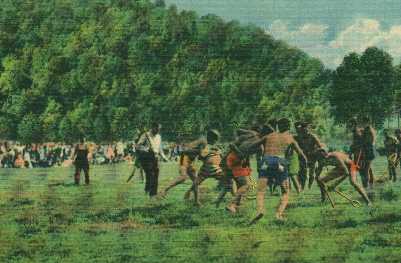
Here is a Cherokee stickball game being played
in the Smokey Mountains back east.
English and Scotch traders had set up
trading posts in the Southeast United States as early as the 1650s. For
100 years these traders made no attempt to take the Indian's land. They
just traded with them. This allowed these tribes to learn European ways
and adopt European technology like metal tools. By the time larger numbers
of settlers began to arrive these civilized tribes had already adopted
European farms, tools, dress and many customs as well. The Cherokees had
even invented a Cherokee alphabet and system of writing and were publishing
newspapers in Cherokee. To the settlers they seemed very civilized and
they were.
As the English settlers, and later the
American settlers moved in all around them in the east the Cherokees had
less and less land. They needed land to farm and hunt on. The Americans
around them were hostile and made trouble for the Cherokees. There were
battles and many fights. One of the tribes of the Cherokee decided they
were tired of the fighting and decided to move west and look for new land
where they would be left alone.
This was the part of the Cherokees led
by Chief Duwali. Duwali is his Cherokee name. Duwali also used English
versions of his name "John Bowls and Colonel Bowls. Chief Duwali first
led his people west to what is now Arkansas. They lived there for a while.
Later they moved to East Texas. After being cut off from the Eastern Cherokees
who stayed behind, Chief Duwali's Cherokees became the Western band of
the Cherokees.
They moved into the area of Texas the
Caddo Indians lived in. By 1823 the Caddo had lost much of their former
population to European diseases. By the time the Cherokee arrived, the
Caddo were down to no more than two thousand. So, much of the land the
Caddos had lived on was empty by 1823. Along with the Cherokee, several
other tribes from the Southeastern United States also moved into this region
of Texas. These were the Alabama, the Coushatta, the Shawnee, the Biloxi,
some Creek Indians and a few other smaller groups.
They all arrived at a critical time
in Texas history. Texas was part of Mexico in 1823. In the next 25 years
there would be a revolution in Mexico, the Texas revolution, and Texas
would become a part of the United States. During this same time period
thousands of Americans and Europeans immigrated to Texas wanting land -
including the land the Indians lived on.
In all these revolutions both sides
wanted the Cherokees and the other tribes to take sides with them. This
was dangerous for the Cherokees. If they chose sides with a loser, the
winner would punish them afterwards and chase them off their land. They
stayed neutral in these revolutions.
Even after Texas won the revolution,
agents of the Mexican government came to the Cherokees and asked them to
make war on the Texans. The Cherokees refused to do this.
In February of 1836 Sam Houston negotiated
a treaty with the Cherokees on behalf of the Provisional Government of
Texas. When Sam Houston became president of the Republic of Texas in September
of 1836, he tried to get the 1836 treaty ratified by the new Texas Government.
They did nothing about the treaty until 1837. In 1837 the Texas Senate
rejected the treaty signed by Houston. Still, while Houston was president,
things were all right for the Cherokee for several years. Then Texas elected
a new President, Mirabeau Lamar. Lamar did not like the Cherokees, or any
other Indians for that matter, and he said so. Lamar and other were also
concerned because the Mexicans were trying to get the Cherokees and other
Texas Indians to help them take back Texas.
Here is a part of letter Lamar sent
to Chief Duwali. Lamar wanted the Cherokees out of Texas so American settlers
could take their land, along with the land of the remaining Caddos and
the many other tribes living in east Texas.
"… I therefore feel it
to be my duty as Chief Magistrate of this Republic, to tell you, in the
plain language of sincerity, that the Cherokee will never be permitted
to establish a permanent and independent jurisdiction within the inhabited
limits of this Government: that the political and fee-simple claims, which
they set up to our territory now occupied by them, will never be allowed,
and that they are permitted, at present, to remain where they are , only
because this Government is looking forward to the time, when some peaceable
arrangements can be made for their removal, without the shedding of blood,
but that their final removal is contemplated, is certain: and that it will
be affected, is equally so. Whether it be done by friendly negotiation
or by violence of war, must depend on the Cherokee themselves . . .
May 26th 1839, signed by Mirabeau
Lamar"
In July of 1839 Texas sent troops to
remove the Cherokees. On July 15 there was a skirmish near Duwali's village.
Duwali tried to lead his people north along the Neches River to escape,
but the Texas militia pursued them There was a battle on July 17th near
the headwaters of the Neches River in what is now Van Zandt county. Chief
Duwali was 83 years old by this time, but he still lead his braves into
the battle. According to eye witness accounts he stayed at the front of
his men during the entire battle. The fighting was fierce and there were
many casualties. After the Cherokee began to lose, and when most of the
Cherokees had retreated, Chief Duwali stayed on the battle field with the
last of his men to help the others retreat safely. He was shot and fell
down. As he lay dying a Texas Militia man came up and shot him in the head
at close range. Chief Duwali was dead along with 100 other Cherokees.
The Texas Cherokees moved to Indian
Territory in what is now Oklahoma. There, they were reunited with the eastern
Cherokees. The eastern Cherokees had also been forced to move from their
lands. The government of the United States and the State of Georgia forced
the eastern Cherokees off their land and forced them to move to Indian
Territory in Oklahoma. The United States Supreme Court ruled that this
was an illegal act and broke treaties.
The Cherokees, men, women, children
and babies, the elderly and sick were all marched at gun point by army
troops from Georgia to Indian Territory during the winter of 1839. Many
of them died along the way from the cold and from starvation because the
army would not feed them properly. This march is remembered as "The
Trail of Tears" because so many women and children died during this
forced march. A few of them ran away into the hills and stayed.
They lived on a reservation in the Indian
Territory in the eastern part of what is now the state of Oklahoma. In
1889 the United States Government began pressuring the Cherokee to sell
their land. They did sell a large area of northwest Oklahoma called the
Cherokee Strip to the government in 1893. That same year the Dawes Commission
was set up to get the 5 civilized tribes to give up their reservations
and tribal governments. White settlers wanted the Indian land.
The Cherokee refused to even talk to
the Dawes commission at first. Finally they were forced into an agreement.
In 1902 every Cherokee was given 110 acres of reservation land. This was
called allotment. Allotment means dividing something up and allotting (giving)
the parts to individuals. An allotment is like a share. This is when tribal
members were officially enrolled (listed) as members of the tribe. This
was done by the United States Government. You had to be an enrolled tribal
member to get an allotment of land. Many Cherokees who did not want land
or who refused to participate in an American Government controlled program
did not enroll. People still argue today about who is and who is not a
Cherokee because of the Cherokees who did not enroll. All the land that
was not allotted, and there was a lot of it, was taken by the United States
Government and sold to the railroads and to white settlers.
The tribal government was supposed to
be dissolved too, but it went on anyway. In 1914 the US Congress passed
a new law allowing the tribal government to operate again.
The whole purpose of the Dawes commission
was to destroy the tribes. Dissolving the reservations and tribal governments
was supposed to force the Indians to forget their past culture and heritage
and live like Whites. Of course back then there were laws that made them
second class citizens because of their race. Indians were discriminated
against and treated much the same as black people were treated, even worse
in many cases. Many Cherokees were passing as white persons back then and
this is one reason many of them did not enroll.
For you younger readers, there were
many laws and customs in 1906 that discriminated against what were called
"persons of color" or colored persons. Persons of color were
Africans, Mexicans, Chinese and of course Indians. Of course the term colored
means their skin was not white. There were laws back then called Jim Crow
laws that banned colored persons from sitting in or eating in white only
restaurants. Persons of color were not allowed in the city limits of many
towns after dark. Businesses could refuse to do business with them and
did so. In some places Jim Crow laws required persons of color to always
be employed or be sent to prison to work on convict labor gangs. Persons
of color or "coloreds", as they were called by whites, were not
allowed to vote, not allowed hold elected office, and were not allowed
to sue or use the court system. Their children had to go to substandard
colored schools and often had no schools after the sixth grade. Many jobs
and professions were forbidden to coloreds. Most colleges in the south
refused colored students by law. In most towns they had to live in colored
sections of town and could not buy or live in white only parts of town.
So, if an Indian could pass as being white they did. Many did not want
to enroll and come under the Jim Crow laws.
The allotted land the Indians were supposed
to own was not really theirs. The land was held in trust for each Indian
by the United States Government. This means the government could sell the
land without the permission of the Indian who was supposed to own the land.
The government also held onto the money from any such sale, in trust. The
Indian could not sell the land without the permission of the Government.
The Government had full management of the allotted land. In many cases
Indian land was sold to railroads and whites against the wishes of the
Indian owner.
The Burke Act of of 1906 ended the holding
in trust of Indian lands, but added a new twist. The Burke Act declared
all Indians incompetent to manage their affairs. An Indian had to get a
certificate of competency to manage his or her land. Until an Indian was
declared competent the government managed his or her land and financial affairs, just like the old trust system. Many
Cherokees were doctors and lawyers and educated professionals by this time.
Even these persons were held to be incompetent till the applied for and
passed the tests to be certified competent.
Most of the Cherokees still live in
Oklahoma. They have a large tribal center in the town of Tahlequah. I have
visited it and it is very nice. The Cherokee who ran away and stayed behind
also have a reservation back east in the Carolinas.
They have modern houses and schools
in towns that are just like any other modern American town. There are K-Marts
and gas stations. There are Cherokee doctors and lawyers along with truck
drivers and construction workers. Cherokee kids have to do math homework
just like you do.
| 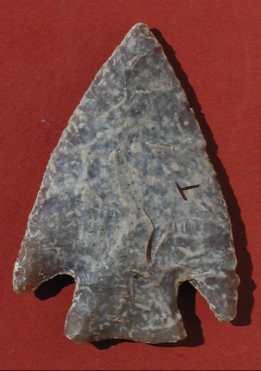 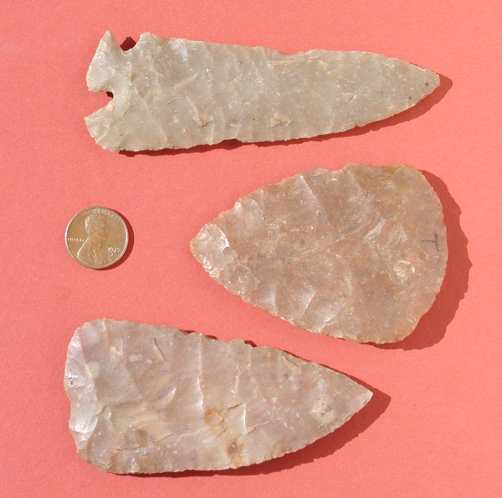 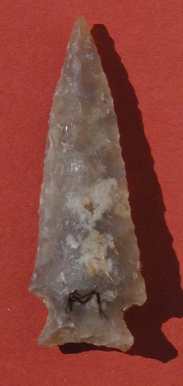
Look at the flint tools!! We
have more. Look in the opening page. |
Cherokee names / languages
Cherokee : CHA LA GI Indian :
a-yv-wi-ya
Hello : o si yo
Welcome : tsi lu gi
Alligator : tsu-la-s-gi
Ant : do-sv-da-li
Bat : tla-me'-ha
Beast (4 legged) : nv-gi di-ga-nv-sa-di
Bird : tsi'-s'qua
Bluebird : tsa-quo'-la-de
Bobcat : gv-he
Buffalo, buffaloes : yansa
Butterfly : ka-ma-ma
Cat : we-sa
Chipmunk : ki-yu:-ga
Crow : ko:-ga
Deer : v'-s-gi-yi
Dragonfly : wa-da-du-ga
Duck : ka-wo
Eagle : wo-ha'-li
Elk : a-wi e-qua
Fox : tsu'-la'
Red Fox : tsu-la u-wo-di-ge
Horse : so'-qui-li
Hummingbird : wa-le-li
Lion : tla-da-tsi or hlv-da-ji
Lizard : ti-yo'-ha-li'
Mosquito : do-sa
Owl : wa-hu-hi
Polar bear : yo-na u-ne-ga
Oppossum (smiling pig) : si-quu:-tse-ts'
Raccoon : kv-tli
Rattlesnake : u-tso'-n-ti'
Skunk : di?-li
Spider : ka-na-ne'-s-gi
Turkey : gv-na
Water mocassin : u'-ga-n'-te:-na
Wildcat : ka he
Wolf : wa-hya
Zebra : so-gwi-li tsu-lv-da-nv-ni.
Yes, They have a name for zebra now.
Goodbye : do na da' go hv i
Copyright by R. Edward Moore and Texarch
Associates, 1999, 2012 all rights reserved. Graphics may not be used or
reproduced without prior permission. Short parts of text may be quoted
in school reports. Longer quotes require prior written permission.
 Since 2-1-2005 Reset several times. 2012
Since 2-1-2005 Reset several times. 2012